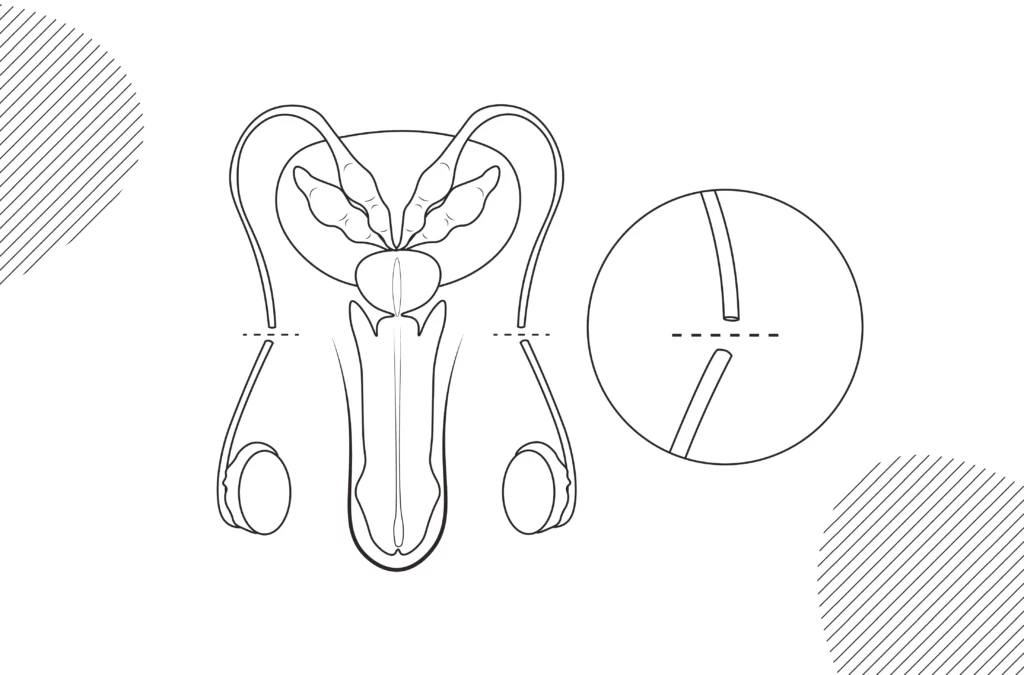Vasectomy 101
Male vasectomy is a permanent family planning procedure that involves cutting or blocking the vas deferens, which carry sperm from the testicles to the semen. This prevents sperm from mixing with semen and therefore prevents fertilization. Basically, it is a male sterilization process.
Phew! You may feel a bit put off by this contraceptive technique after the previous paragraph, but I assure you there’s no reason to be afraid of male vasectomy.
How is it performed?

The procedure is simple and performed in an outpatient setting, making vasectomy a safe option. It is usually carried out with local anesthesia and lasts approximately 20 to 30 minutes. The vasectomy procedure in Spain does not require a work leave (no, there are no days off for getting a vasectomy). Recovery after the procedure is immediate. Many people undergo the procedure on Friday, rest during the weekend, and return to work on Monday without any issues.
On the other hand, laser vasectomy is a non-invasive form of vasectomy that uses a laser to cut and seal the vas deferens. It is also performed under local anesthesia and generally requires less recovery time than traditional vasectomy. However, the effectiveness and safety of laser vasectomy are not fully established yet, and it may be more expensive than traditional vasectomy. That being said, let’s talk more about all the advantages of both techniques.
Vasectomy for everyone?
It is important to note that vasectomy is a personal decision and should be discussed with a doctor or health care provider.
The pros and cons need to be carefully weighed before making a decision. Vasectomy may not be ideal for all men and there may be other contraceptive options that are more suitable for certain individual situations. In case you still have any questions, here are some of the most frequently asked questions (and misconceptions) about vasectomy.

Advantages of vasectomy
Vasectomy offers many benefits, including a permanent and effective alternative to other contraceptive methods such as condoms or birth control pills. Furthermore, it will not interfere with sexuality or alter hormone production. Vasectomy is a convenient and affordable option (we’ll discuss this later) for those who don’t want to have (more) children.
Moreover, vasectomy is a safer option than other permanent family planning procedures such as tubal ligation in women. Vasectomy has no long-term side effects and does not affect hormone production or sexuality. Additionally, it is important to note that vasectomy is reversible.
The long-term cost of vasectomy is one of the main reasons why it is such a popular contraceptive method. Over a 10-year period, vasectomy costs between 0 and 100 euros per year in Spain (depending on whether it is done through the public system or at a private clinic). For sexually active people, the average annual costs of other contraceptive methods are as follows:
- Condoms: 100-400€
- Cervical cap: 1000-3000€
- Sponge: 500-1500€
- Birth control pills: 50-300€
- Contraceptive patch: 200€
It’s important to note that many female contraceptive methods involve a change in hormone levels and may have side effects, while vasectomy in men does not have these implications.
But what are the cons?
Some of the potential drawbacks of vasectomy include the possibility of pain or inflammation after the procedure, and the need to wait until semen tests have been performed to confirm that the vasectomy has been effective. There is also a very rare chance (less than 0.1%) that the vasectomy may not be effective, resulting in an unwanted pregnancy.
What if I change my mind?
Although many men are satisfied with their decision to undergo a vasectomy, a small percentage (between 6 and 10 percent, according to the Cleveland Clinic) may change their minds.
Vasectomy reversal (vasovasostomy) undoes the vasectomy procedure by reconnecting the severed ends of each vas deferens. Like the vasectomy, it can be performed under local anesthesia or, more commonly, under general anesthesia by a certified urologist.
In more complicated situations, the cut end of the vas deferens is directly attached to the epididymis, where sperm is stored. This is called an epididymovasostomy and should only be performed by an experienced specialist.
Reversals carry risks, such as infections, bleeding, and, in rare cases, chronic pain. Some restrictions on activities (such as having sex with medium or high physical intensity) and tight clothing are recommended for a few weeks. After that time, you can try to conceive again.
Although almost all vasectomies can be reversed, not all vasovasostomies allow for fertility to be restored. The success rate of pregnancies after vasectomy reversal ranges from 30 to 90 percent, a seemingly wide interval explained by the time elapsed between the vasectomy and the reversal: a reversal after 10 years will have higher success rates than those performed after 20 years.

Let’s talk about false beliefs and mythology
Myth #1: Vasectomy can cause erectile dysfunction (ED) by damaging male genitals.
Reality: A properly performed vasectomy does not cause any damage to the testicles, prostate, or penis.
Myth #2: Vasectomy can cause prostate cancer.
Reality: There is no proven link between vasectomy and prostate cancer, nor any other type of cancer or degenerative disease. The only risk, which is minimal, comes from a possible infection after the procedure and pain associated with the healing process. However, most men do not suffer infections, and the recovery time from a vasectomy is quite short.
Myth #3: Vasectomy will reduce my testosterone levels.
Reality: Vasectomy does not affect a man’s hormone levels. This myth may be partly attributed to the gradual reduction in testosterone levels as men age. Often, many men choose to have a vasectomy at an age when testosterone is already starting to decline anyway. Otherwise, vasectomy and low testosterone are not related.
Myth #4: Vasectomy will affect my erections and ejaculations.
Reality: No, vasectomy does not have a negative effect on erection or ejaculation. Vasectomy only prevents sperm from mixing with semen during ejaculation, making the ejaculation sterile. The amount of semen and sensation during ejaculation usually does not change after vasectomy. Erection and libido also typically remain intact.
Conclusion
In summary, male vasectomy is a permanent and effective way to avoid unwanted pregnancies. It offers many pros, such as convenience, effectiveness, and safety, but it also has some cons, such as the possibility of pain or inflammation after the procedure. It is important to talk to a doctor or healthcare provider before making a decision about whether vasectomy is right for you. Have you made any decisions after reading this article?

Author: Andrés Suro (Sexual Coach at MYHIXEL)
Psychologist specialized in the social area and expert in sexology applied to education.
Remember you can book a private consultation with me at MYHIXEL CLINIC. Book your appointment here.
Do you have any questions about our online consultation service? Contact us through our WhatsApp Business +34 643 84 91 23






